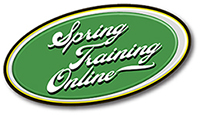Anyone visiting Vero Beach’s Dodgertown knows one of the joys of that historic complex was the ability to wander around and view the whole gamut of player development, ranging from scrimmages at bareboned practice fields to games at Holman Stadium.
That power to wander around in mimicked in the impressive new Camelback Ranch spring-training complex now shared by the Los Angeles Dodgers and the Chicago White Sox. And while there’s little at Camelback Ranch that’s a direct homage to Dodgertown, the same atmosphere of openness and transparency can be found throughout the complex.
Most fans will enter the ballpark at the parking lot located at West Camelback Road and 107th Avenue, west of the Camelback/I-101 interchange. (Those holding premium parking passes will enter at the opposite end of the complex, heading directly into the ballpark.) This 1,000-plus parking lot is in the southeast corner of the complex, with the ballpark on the northwest corner and the training fields in between.
To get to the ballpark, you will walk through the training complex. The main path goes from the lot to the ballpark’s center-field entry, with the White Sox training complex on the left and the Dodgers’ complex on the right. Each team has two MLB field and four minor-league fields, as well as a half infield and specialized areas for sliding and bunting drills. A three-acre-plus pond separates the two training areas; besides serving as a holding pond for reclaimed water destined for watering the grounds, the pond serves an aesthetic function: it’s ringed by a Walk of Fame where tribunes to legends from both teams are envisioned someday. Paths branch out from roughly the center of the complex to each team’s MLB-sized practice fields.
The 141-acre site isn’t purely symmetrical, reflecting each team’s approach to player development. On the White Sox side, you have nothing but training fields; the main MLB field has limited access, with fans kept a distance from the players. On the Dodgers side, the main MLB practice field is almost totally open to fans. While there’s seating (but no shade) in both practice fields, it’s pretty clear the Dodgers want to encourage players to interact with fans — at least more than the White Sox braintrust does, for now.
After you make their way through the training complex, you’ll be presented with what’s shaping up to be the best ballpark in the Cactus League. A symmetrical two-building outpost in center field houses the main ticket office, the largest team store and other operations. The curved buildings immediately set the tone for the spring experience at Camelback Ranch: the 14 buildings comprising the complex were designed to appear to rise from the flat Valley floor, with sloping roofs, asymmetrical designs and organic appearances. It also sits slightly off the trees in back of the batters eye, giving fans a view of the field and home plate as they approach the field of play.
The ballpark seats 13,000 (10,099 fixed seats, the remainder on the berm), but it feels smaller. Though the complex is set on 141 acres, the ballpark takes up a very small part of that, and the combination of below-grade playing field and surrounding outbuildings carves out an intimate space. The theme throughout the ballpark is focused on natural materials and finishes; besides the gabion walls so prominent in the outfield concourse, the buildings have a stone or brown finish, and the outbuildings feature angled roofs designed to feel like a natural part of the desert skyline. The seats are done in a desert brown; when surrounded by so many neutrals and browns, the green grass will be especially resplendent.
In back of the grandstand is an entrance for premium seatholders — you know, the people who pay between $90 and $120 for a ticket — as well as more concessions. There will be points of sale on the concourse as well.
As you sit in the grandstand, you’ll see two buildings down each line. Down the first-base line is the White Sox clubhouse/training facility, and down the third-base line is the Dodgers major-league clubhouse. Both teams will enter the field from the clubhouses, albeit in slightly different ways: the White Sox will enter from a truck entrance, while the Dodgers will enter through a small tunnel under the outfield concourse and through the bullpen. You’ll be able to see each team from the concourse, but you won’t be very close to the players.
When the game starts, take a good look at the second floor of the outfield buildings past the wraparound concourse, because that’s where team officials will be. Dodger owner Frank McCourt commands a large suite and deck on the center-field side of the Los Angeles building – there’ll be no escaping him and his guests during the course of a game – while White Sox owner Jerry Reinsdorf has a smaller suite and deck on the center-field side of his building. The executive offices are spacious, but not sumptuous; both teams promise to use the complexes as year-round training and development facilities, so the office space is needed.
If you go, be prepared to make a day of it. You’ll want to give yourself plenty of time to meander your way through the complex before the game, and it will take some time to make your way back to your car after the game. (Once there, it shouldn’t take long to leave the ballpark; Camelback Road between the complex and the free was widened to four lanes and a center turn lane to accommodate spring-training crowds.) But go: Camelback Ranch will provide one of the most scenic spring-training experiences in all of baseball.

Comments are closed.